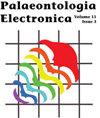美国南卡罗来纳州查尔斯顿湾渐新世的一种巨齿鲨(Carcharocles angustidens)幼崽
IF 1.5
4区 地球科学
Q1 Earth and Planetary Sciences
引用次数: 3
摘要
许多现存的鲨鱼成年后都是世界性的,但幼年时栖息在保育区,通常是浅层、动态的生态系统,新生儿和幼年时有大量猎物。巨齿鲨(Otodontidae)是有史以来最大的鲨鱼,在巴拿马、西班牙、佛罗里达和马里兰州的中新世,巨齿鲨的繁殖区已经被证明。早期的一项研究假设,在南卡罗来纳州查尔斯顿的上渐新世(23-25 Ma)钱德勒桥组中,有一个angustidens Carcharocles的苗圃区。我们通过报告和分析两个集合(n=127)来验证这一点,这两个集合主要是钱德勒桥组的C.angustidens的小牙齿和下渐新世(29-26.57Ma)Ashley组的一些牙齿(n=9)。通过校正牙齿位置,已发表的体长估计方程得出大多数个体的体长估算值为1.5-6.5米。基于大小的年龄分类(新生儿、青少年、成年人)是根据较大的巨齿龙进行修改的,并根据本文报道的最大可用的狭齿龙标本进行缩放。这些群落以小型个体(青少年和新生儿)为主,很少有成年人。因此,渐新世查尔斯顿湾是第一个有记载的安氏锥虫古繁殖区。艾迪森·米勒。美国南卡罗来纳州查尔斯顿市查尔斯顿学院地质与环境地质系29424。addisonemiller12@gmail.com马修·吉布森。查尔斯顿博物馆,美国南卡罗来纳州查尔斯顿29403。mgibson@charlestonmuseum.orgRobert Boessenecker,梅斯·布朗自然历史博物馆和地质与环境地质系,查尔斯顿学院,查尔斯顿,南卡罗来纳州29424。通讯作者。boesseneckerrw@cofc.edu本文章由计算机程序翻译,如有差异,请以英文原文为准。
A megatoothed shark (Carcharocles angustidens) nursery in the Oligocene Charleston Embayment, South Carolina, USA
Many extant sharks are cosmopolitan as adults but inhabit nursery areas as youngsters often shallow, dynamic ecosystems with abundant prey for neonates and juveniles. Megatoothed sharks (Otodontidae) were the largest sharks of all time, and nursery areas have been demonstrated for Carcharocles megalodon in the Miocene of Panama, Spain, Florida, and Maryland. An earlier study hypothesized a nursery area for Carcharocles angustidens in the upper Oligocene (23-25 Ma) Chandler Bridge Formation of Charleston, South Carolina. We tested this by reporting and analyzing two collections (n=127) dominated by small teeth of C. angustidens from the Chandler Bridge Formation and some teeth from the underlying lower Oligocene (29-26.57 Ma) Ashley Formation (n=9). Correcting for tooth position, published body length estimation equations yielded body length estimates of 1.5-6.5 m for most individuals. Size-based assignment to age classes (neonates, juveniles, adults) is modified from the larger C. megalodon and scaled based on the largest available specimens of C. angustidens, reported herein. These assemblages are dominated by small individuals (juveniles and neonates) and include few adults. The Oligocene Charleston embayment therefore represents the first documented paleo-nursery area for C. angustidens. Addison Miller. Department of Geology and Environmental Geosciences, College of Charleston, Charleston, South Carolina 29424, USA. addisonemiller12@gmail.com Matthew Gibson. Charleston Museum, Charleston, South Carolina 29403, USA. mgibson@charlestonmuseum.org Robert Boessenecker, Mace Brown Museum of Natural History and Department of Geology and Environmental Geosciences, College of Charleston, Charleston, South Carolina 29424, USA. Corresponding Author. boesseneckerrw@cofc.edu
求助全文
通过发布文献求助,成功后即可免费获取论文全文。
去求助
来源期刊

Palaeontologia Electronica
地学-古生物学
CiteScore
3.60
自引率
0.00%
发文量
20
审稿时长
>12 weeks
期刊介绍:
Founded in 1997, Palaeontologia Electronica (PE) is the longest running open-access, peer-reviewed electronic journal and covers all aspects of palaeontology. PE uses an external double-blind peer review system for all manuscripts. Copyright of scientific papers is held by one of the three sponsoring professional societies at the author''s choice. Reviews, commentaries, and other material is placed in the public domain. PE papers comply with regulations for taxonomic nomenclature established in the International Code of Zoological Nomenclature and the International Code of Nomenclature for Algae, Fungi, and Plants.
 求助内容:
求助内容: 应助结果提醒方式:
应助结果提醒方式:


